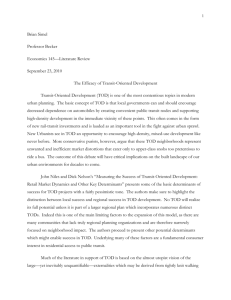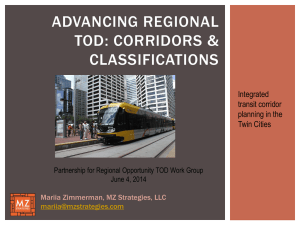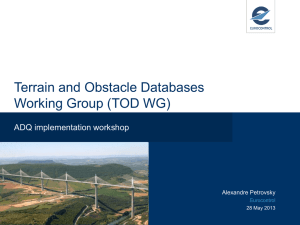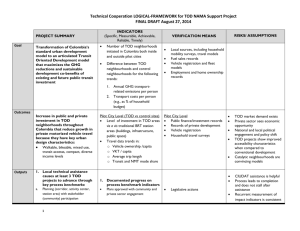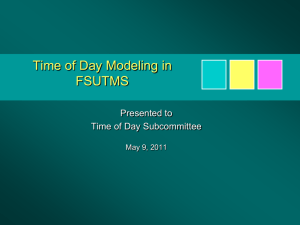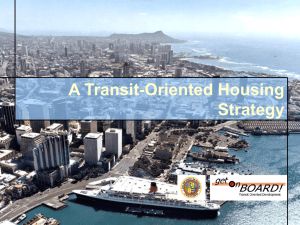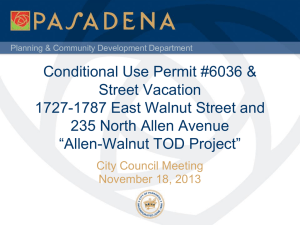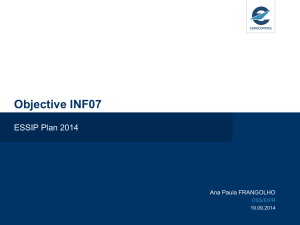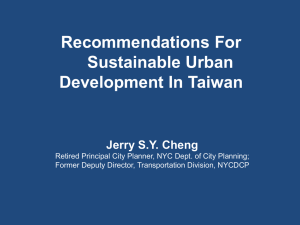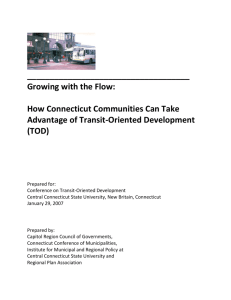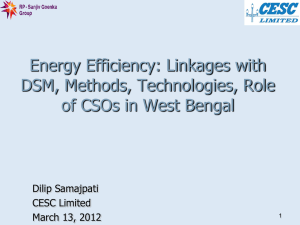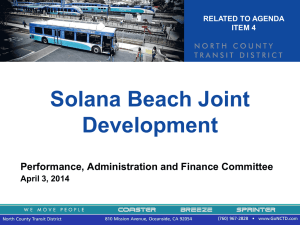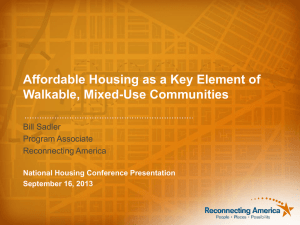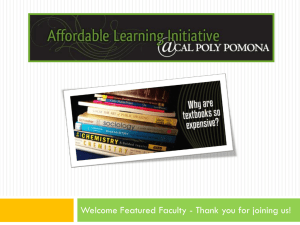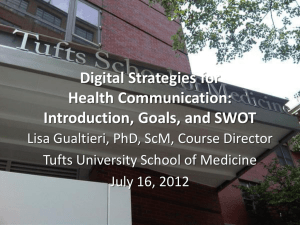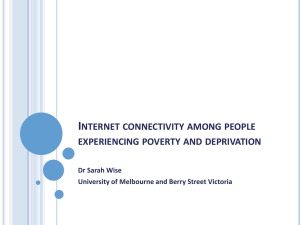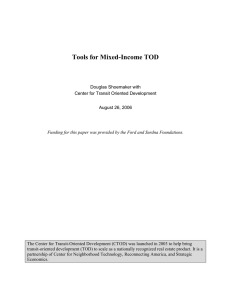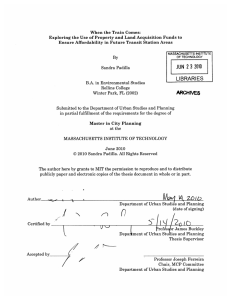Prince George`s Plaza Metrorail Station
advertisement
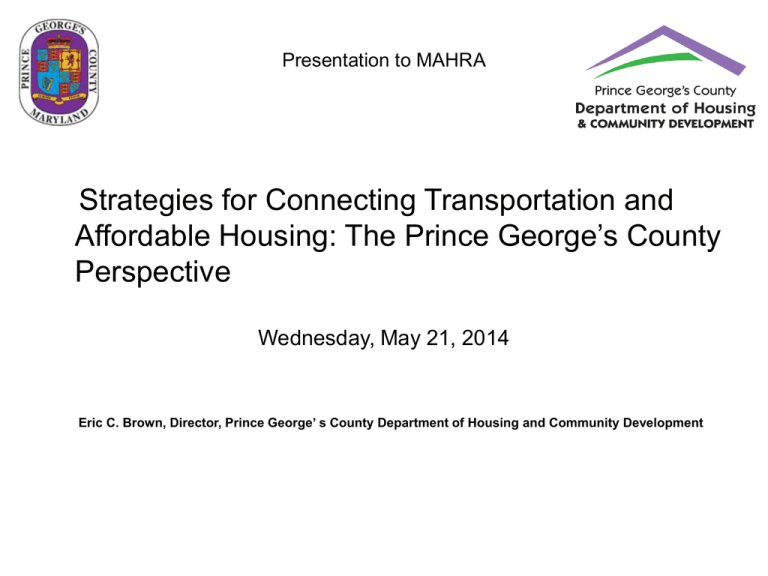
Presentation to MAHRA Strategies for Connecting Transportation and Affordable Housing: The Prince George’s County Perspective Wednesday, May 21, 2014 Eric C. Brown, Director, Prince George’ s County Department of Housing and Community Development What is Transit Oriented Development • Transit-oriented development, or TOD, is a type of community development that includes a mixture of housing, office, retail and/or other commercial development and amenities integrated into a walkable neighborhood and located within a half-mile of quality public transportation. ( Center for Transit Oriented Development) • TOD creates better access to jobs, housing and opportunity for people of all ages and incomes. ( Reconnecting America) Benefits of TOD • • • • • • • • Reduced household driving and thus lowered regional congestion, air pollution and greenhouse gas emissions Walkable communities that accommodate more healthy and active lifestyles Increased transit ridership and fare revenue Potential for added value created through increased and/or sustained property values where transit investments have occurred Improved access to jobs and economic opportunity for low-income people and working families Expanded mobility choices that reduce dependence on the automobile, reduce transportation costs and free up household income for other purposes Reduced household spending on transportation, resulting in more affordable housing Reduced incentive to sprawl, increased incentive for compact development Obstacles to TOD • Land prices around stations are high, or increase because of speculation when a new transit line is planned. • Affordable housing developers don’t have the capital to acquire land before the prices go up and hold it until it’s ready to be developed. • Funding for affordable housing is limited. • Mixed-income and mixed-use projects require complex financing structures. • Sites often require land assembly and rezoning, leading to lengthy acquisition and permitting processes that increase costs. • Community opposition to density and affordable housing can be challenging. Community outreach and education up front can be very helpful, but also time-consuming and costly. • Affordable development at these sites requires collaboration among the public, private and nonprofit sectors, which can be difficult to coordinate given the different needs, constraints and schedules of each partner. Obstacles to TOD Existing single-use zoning and suburban style parking minimums can reduce the development potential and make construction of affordable units financially infeasible Affordable housing developer have a difficult time getting projects financed Strategies and tools to support Affordable Housing Near TOD • Develop a comprehensive strategy for the production and preservation of affordable housing near transit centers • Engage and obtain the broadest community support • Expedite the review of TOD projects • Reduce parking requirements for TOD • Inclusionary Zoning • Flexible Zoning • Right of First Refusal Prince George’s County TOD Perspective • • • The county is home to 15 of the region's 86 Metrorail stations. Within one-half mile of the county's Metrorail stations are over 2,500 acres of undeveloped land, providing ample opportunities for innovative, mixed-use development with a strong emphasis on transit-oriented design. Prince George’s County has launched specific strategies to “jump start” Transit Oriented Development Components to Jump starting TOD in Prince George’s County 1. Focus All 15 County Metro Stations will benefit from this initiative, but five Metro Stations are established as the highest priority for financial and other incentives. 2. Infrastructure The County commits to support infrastructure needs the priority stations, including source of funds and timetable. 3. Fast-track TOD projects will move through the regulatory approval process with unprecedented speed. 4. Financial Incentives Tax credits, grants, low-cost loans, bond financing and fee reductions will be used to reduce private development costs. 5. Vision & Marketing Each Metro Station will build a unique “brand” suited to its particular market strengths. 6. Leadership & Collaboration The County will take a leading role in working with local, state, regional and federal partners to implement TOD. Focus on Five High Priority TOD Largo Town Center Metrorail Station • • • Located west of Lottsford Road, south of Arena Drive, and north of Central Avenue (MD 214). The nearest communities are Lake Arbor and Largo. Access is via Landover Road (MD 202), Harry S Truman Drive, Arena Drive, Lottsford Road, and Brightseat Road. Prince George's Plaza Metrorail Station • • • • Located at the intersection of East West Highway (MD 410) and Belcrest Road. The nearest communities are the City of Hyattsville, the City of College Park, and the Town of University Park. The station area is within a transit district overlay zone (TDOZ). Access is via East West Highway (MD 410), Queens Chapel Road (MD 500), Adelphi Road, and Belcrest Road. New Carrollton Metrorail Station • • • At the eastern end of the Orange Line at the Capital Beltway, a major mixed-use transit center is taking shape as plans for additional office (including Maryland DHCD headquarters), local-serving retail, and multifamily residential uses within easy walking distance. This station is a major multimodal hub with Metro, AMTRAK, MARC, a Greyhound Bus Terminal, and local County bus service available. Internal Revenue Service headquarters employ 5,000 workers and the 200-acre Metro East Office Park is located southeast of the station Suitland Metrorail Station • • • • Adjacent to the Suitland Federal Center with over 7,000 employees, the plan calls for new development and redevelopment that will provide housing and services for Federal Center employees, quality commercial space, a variety of housing types, a mixedincome neighborhood, and homeownership opportunities for the community. Located north of Suitland Parkway at the intersection with Silver Hill Road. Adjacent to the Metro station is the Suitland Federal Center, which employs 9,150 people. Access is via Silver Hill Road, Suitland Parkway, and Branch Avenue (MD 5). Branch Avenue Metrorail Station • • • Branch Avenue is the last station on the southern Green Line, located just north of the Capital Beltway. Located just inside the Capital Beltway (Interstate 95/495), east of Branch Avenue, and north of Auth Road. The nearest communities are Auth Village and the Town of Morningside. Strategies for TOD • • • • • Focus on five Metro stations Expedited review of TOD projects in priority areas Flexible Zoning Tax Increment Financing Right of First Refusal Strategies for connecting Transportation and Affordable Housing QUESTIONS?

